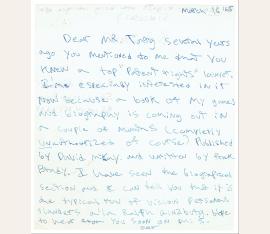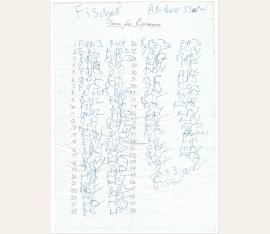11. Schachweltmeister (1943-2008). Autograph letter signed. New York. 4to. 1 1/2 pp.
$ 6,911 / 6.500 €
(87991)
To „Mr. Targ“, whom he asks for help whom he asks for help because of a biography that has not been authorised by him. „[…] several years ago you mentioned to me that you knew a top ‘Patent rights’ lawyer. I’m especially interested in it now because a book of my games and biography is coming out in a couple of months (completly unauthorized of course) published by David McKay and written by Frank Brady. I have seen the biographical section and I can tell you that it is the typical run of vicious personal slanders à la Ralph Ginzburg […]“ Bradys biography „Profile of a Prodigy.
The Life and Games of Bobby Fischer“ was published in 1973 by David McKay in New York. Autograph letters by Fischer are extremely rare..
11. Schachweltmeister (1943-2008). Autograph Manuscript Signed, "Fischer" twice. No place, no date [Siegen, 26 September 1970]. 4to. 1 p. Ruled paper; marked cockling overall, folds, four punch holes in left margin.
$ 6,911 / 6.500 €
(89499)
Autograph Manuscript Signed, "Fischer" twice, his complete score sheet for the exhibition game against Ulf Andersson in Siegen on September 26, 1970. Signed after the last notated move ("Resign") and again in recording the player names at upper edge of sheet. Fischer used descriptive chess notation, which was widely used until the 1970s, when it was replaced by algebraic notation. The first move in this game was Fischer's, who notated "P[awn to]-Q[ueen's k]N[ight ]3"--that is, the pawn nearest the knight on the queen's side of the board moves to the third square.
In algebraic notation, the move is completely and unambiguously described by "b3." The heading, "Game for Expressen," was written out in unknown hand and refers to the sponsor of this particular match, Swedish newspaper Expressen, founded in 1944 and still publishing today. In 1970, an analysis of this game was published in the paper, which likely obtained the moves from this very sheet. After a game, players sometimes sign each other's score sheets to keep as mementos, while some competitions require signing one's own sheet before submitting it to officials. Presumably, either Fischer wasn't interested in Andersson's signature, Andersson delined an invitation to sign, or Fischer was obligated to turn in his score sheet after the game..

